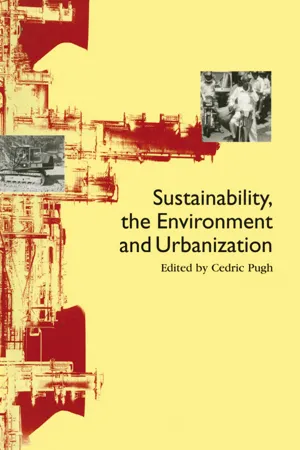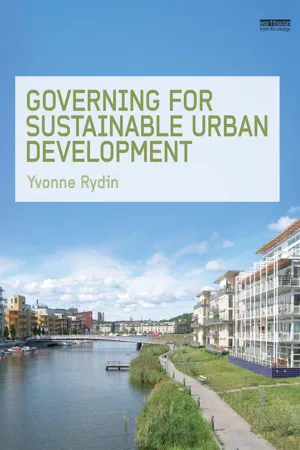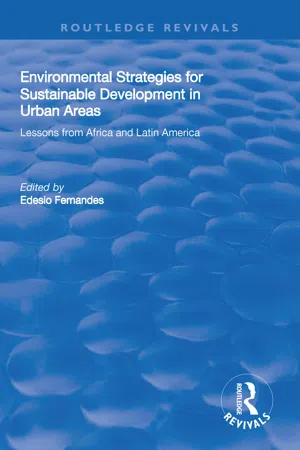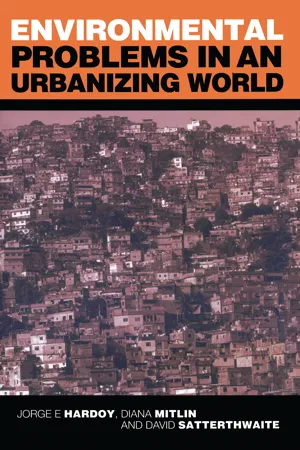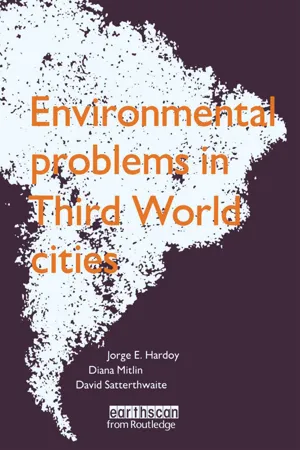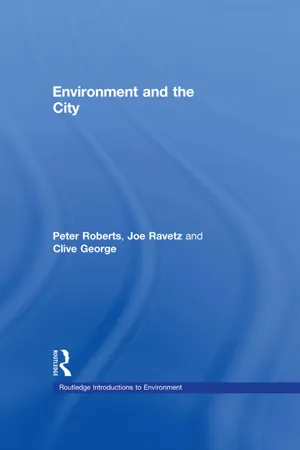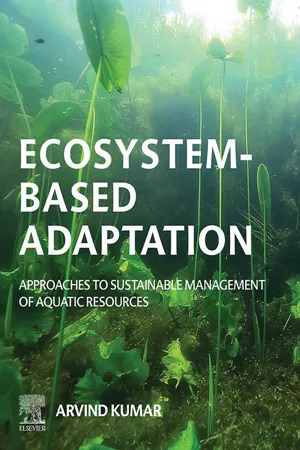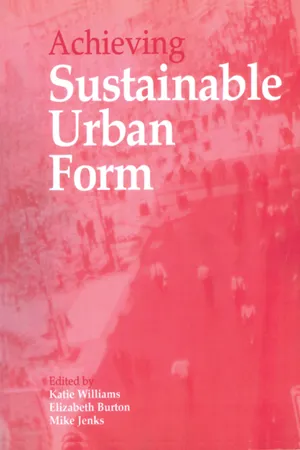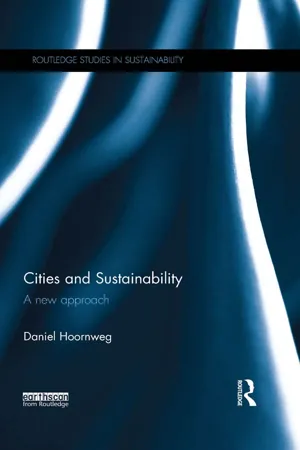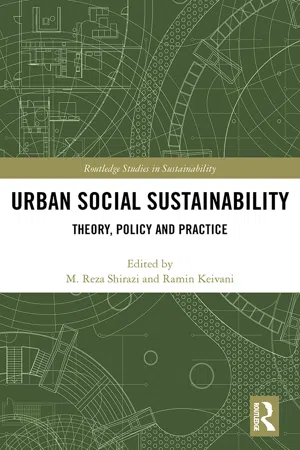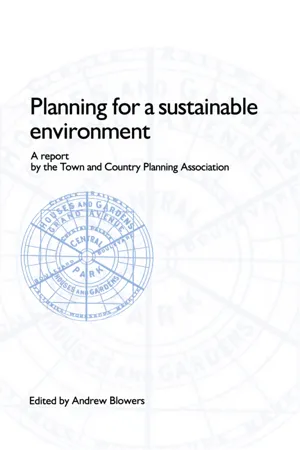Geography
Sustainable Cities
Sustainable cities are urban areas designed to minimize their environmental impact, promote social equity, and ensure economic prosperity for current and future generations. They prioritize efficient use of resources, renewable energy, green spaces, public transportation, and waste management. Sustainable cities aim to create a high quality of life for residents while reducing their ecological footprint.
Written by Perlego with AI-assistance
Related key terms
Related key terms
1 of 4
Related key terms
1 of 3
12 Key excerpts on "Sustainable Cities"
- eBook - ePub
- Cedric Pugh(Author)
- 2014(Publication Date)
- Routledge(Publisher)
This discussion about the territorial boundaries for sustainable development has particular importance for the debate about cities. This chapter is also about sustainable development and cities rather than Sustainable Cities. A concentration on ‘Sustainable Cities’ focuses too much on achieving ecological sustainability within increasingly isolated ‘eco-regions’ or ‘bio-regions’. Seeking ‘Sustainable Cities’ implies that each city has to meet the resource needs of the population and enterprises located there from its immediate surrounds. But the goals of sustainable development are the meeting of human needs within all cities (and rural areas) with a level of resource use and waste generation within each region and within the nation and the planet that is compatible with ecological sustainability. It is unrealistic to demand that major cities should be supported by the resources produced in their immediate surrounds but entirely appropriate to require that consumers and producers in high-consumption, high waste cities reduce their level of resource use and waste and reduce or halt the damaging ecological impacts of their demands for fresh water and other resources on their surrounds.Although the discussions and recommendations about ‘Sustainable Cities’ have much of relevance to reducing the depletion of environmental capital caused by production and consumption in cities in the North, they concentrate too much on individual city performance. What is more important for sustainable development is the local, national and international frameworks needed to ensure the achievement of sustainable development goals worldwide, including the appropriate frameworks for cities.What sustainable development implies for city authoritiesA commitment to sustainable development by city authorities means adding additional goals to those that are the traditional concerns of local authorities. Meeting development goals have long been a central responsibility of city and municipal authorities. Their objectives generally include a desire for greater prosperity, better social conditions (and fewer social problems), basic services, adequate housing and (more recently) better environmental standards within their jurisdiction. This does not imply that city and municipal authorities need be major providers of basic services – and they can act as supervisors and/or supporters of private or community provision. - eBook - ePub
- David Satterthwaite(Author)
- 2021(Publication Date)
- Routledge(Publisher)
Agenda 21 and its prescriptions for solving global environmental problems at the local level are well known. Building on Agenda 21, the Habitat Agenda, signed by 180 nations at the recent Habitat II conference in Istanbul, will also strongly influence the way we run cities. It states: ‘Human settlements shall be planned, developed and improved in a manner that takes full account of sustainable development principles and all their components, as set out in Agenda 21 … We need to respect the carrying capacity of ecosystems and preservation of opportunities for future generations. Production, consumption and transport should be managed in ways that protect and conserve the stock of resources while drawing upon them. Science and technology have a crucial role in shaping sustainable human settlements and sustaining the ecosystems they depend upon.’ 10 What, then, is a sustainable city? Here is a provisional definition: A ‘sustainable city’ is a city that works so that all its citizens are able to meet their own needs without endangering the well-being of the natural world or the living conditions of other people, now or in the future. This definition concentrates the mind on fundamentals. In the first instance the emphasis is on people and their needs for long-term survival. Human needs include good quality air and water, healthy food and good housing; they also encompass quality education, a vibrant culture, good health care, satisfying employment or occupation, and the sharing of wealth; as well as factors such as safety in public places, supportive relationships, equal opportunities and freedom of expression; and meeting the special needs of the young, the old or the disabled - eBook - ePub
- Yvonne Rydin(Author)
- 2012(Publication Date)
- Routledge(Publisher)
1 Sustainable Development and the Urban Agenda IntroductionSustainable development is now widely acknowledged to be an important policy goal, possibly the most important policy goal. This curious and not always well-understood mix of environmental protection, sustained economic activity and social welfare has become the public face of much policy activity. Its profile has been raised by the continuing and growing evidence of the scale and significance of climate change, by the enduring nature of profound social inequalities and even by the reversal of economic fortunes as economies slide into recession.Sustainable development offers the prospect of a very different world and this includes our urban areas, our towns and cities and the built environments that they comprise. Urban areas are central to all aspects of sustainable development. They are centres of economic wealth-creation and yet, at the same time, locations of social deprivation. They can be associated with all sorts of environmental degradation – loss of green space, air pollution, greenhouse gas emissions linked to energy use, waste generation and excessive water consumption to name but a few key aspects – and yet offer the scope for considerable resource efficiencies.This raises the prospects of changing our urban areas to contribute more fully to sustainable development rather than undermine it. Change can, of course, occur within the existing physical fabric but there has been increasing interest in using the processes of urban development to drive change. Understood broadly, urban development can encompass new build, demolition and rebuild, refurbishment, regeneration and area improvement. These all have considerable potential for reshaping the built environments of urban areas.This book looks at the role that urban development can play in delivering sustainable development. It considers how activity at the urban scale is related to the broader concept of sustainable development (the remainder of Chapter 1 ) and elaborates what sustainable urban development means at the scale of the building, the development site, and the urban area or region (Chapter 2 ). After an account of the market processes that drive urban development (Chapter 3 ), the main emphasis of the book is on how processes of governing can shape the delivery of sustainable urban development. Chapters 4 and 5 - eBook - ePub
Environmental Strategies for Sustainable Developments in Urban Areas
Lessons from Africa and Latin America
- Edesio Fernandes(Author)
- 2019(Publication Date)
- Routledge(Publisher)
Today we have the historic opportunity to implement technical and organizational measures for sustainable urban development, arising from agreements signed by the international community at UN conferences in the 1990s. Agenda 21 and its prescriptions for solving global environmental problems at the local level are well known. Building on Agenda 21, the Habitat Agenda, signed by 180 nations at the 1996 Habitat II conference in Istanbul, will also strongly influence the way we run cities. It states:Human settlements shall be planned, developed and improved in a manner that takes full account of sustainable development principles and all their components, as set out in Agenda 21. ... We need to respect the carrying capacity of ecosystems and preservation of opportunities for future generations. Production, consumption and transport should be managed in ways that protect and conserve the stock of resources while drawing upon them. Science and technology have a crucial role in shaping sustainable human settlements and sustaining the ecosystems they depend upon.10What, then, is a sustainable city? Here is a provisional definition: a “sustainable city” is a city that works so that all its citizens are able to meet their own needs without endangering the well-being of the natural world or the living conditions of other people, now or in the future. This definition concentrates the mind on fundamentals. In the first instance the emphasis is on people and their needs for long term survival. Human needs include good quality air and water, healthy food and good housing; they also encompass quality education, a vibrant culture, good health care, satisfying employment or occupation, and the sharing of wealth; as well as factors such as safety in public places, supportive relationships, equal opportunities and freedom of expression; and meeting the special needs of the young, the old or the disabled. In a sustainable city, we have to ask: are all its citizens able to meet these needs? - eBook - ePub
Environmental Problems in an Urbanizing World
Finding Solutions in Cities in Africa, Asia and Latin America
- Jorge E. Hardoy, Diana Mitlin, David Satterthwaite(Authors)
- 2013(Publication Date)
- Routledge(Publisher)
This discussion of the interaction between city-based production and consumption, and resources and sinks from beyond the city boundaries is a reminder that the goal is not Sustainable Cities but cities that contribute to sustainable development goals within their boundaries, in the region around them and globally. A concentration on ‘Sustainable Cities’ focuses too closely on achieving ecological sustainability within increasingly isolated ‘eco-regions’ or ‘bio-regions’. Seeking ‘Sustainable Cities’ implies that each city has to meet the resource needs of the population and enterprises located there from its immediate surrounds. But the goals of sustainable development are the meeting of human needs within all cities (and rural areas) with a level of resource use and waste generation within each region and within the nation and the planet that is compatible with ecological sustainability. It is unrealistic to demand that major cities should be supported by the resources produced in their immediate surrounds, but entirely appropriate to require that consumers and producers in high-consumption, high-waste cities reduce their level of resource use and waste, and reduce or halt the damaging ecological impacts of their demands for fresh water and other resources on their surrounds.Figure 8.3 Contrasts in carbon dioxide emissions per person in 1996 between regions and between selected nationsNote: Many low-income nations have figures of 0.1 or less including Benin, Burkina Faso, Ethiopia, Haiti, The Lao People's Democratic Republic, Madagascar, Malawi, Mozambique, Nepal, Niger, Rwanda, Tanzania and Uganda.The other nations selected are those that are responsible for the largest volume of carbon dioxide emissions that year.Source: Table 10 of ‘Selected World Development Indicators' in World Bank (1999), Entering the 21st Century: World Development Report 1999/2000, Oxford University Press, Oxford and New York, pages 248–249.Although the discussions and recommendations about ‘Sustainable Cities’ have much of relevance to reduce the depletion of environmental capital caused by production and consumption in cities in high-income nations, they concentrate too much on individual city performance. What is more important for sustainable development is the local, national and international frameworks needed to ensure the achievement of sustainable development goals worldwide, including the appropriate frameworks for cities. - eBook - ePub
- Jorge E. Hardoy(Author)
- 2024(Publication Date)
- Routledge(Publisher)
- ‘Renewable resources’. Human use of some renewable resources (such as the direct use of solar power or its indirect use through wind or wave power) does not deplete the resource. But many renewable resources (especially crops and trees) are renewable only within finite limits set by the ecosystem within which they grow. Fresh water resources are also finite; in the case of aquifers, human use often exceeds their natural rate of recharge and as such is unsustainable.
The term sustainable is used both for particular projects/activities and in reference to larger systems (perhaps city-wide, nation-wide or worldwide). It is useful to differentiate between the two applications of the term since both are important in considering sustainable development and cities. Simple inter-relationships between specific development activities (for instance, expanding a piped-water supply or developing a sanitary landfill site) and natural resource-use can be assessed and judged using the criterion of sustainability. Alternatively, the focus can be much broader, concerned with large aggregates and systems of activities. The first approach is concerned with making a single part of the system sustainable. The second approach has a different focus, recognising that it is difficult to make all activities sustainable, and that what is important is that the sum (or net effect) of the activities within a specific area is sustainable. In general, our focus is on the second of these contexts, ensuring that urban systems (and the economies and societies of which they are part) are sustainable, rather than specific urban projects, or even cities. The successful achievement of sustainable development requires society to establish institutions which are capable of ensuring that individual projects add up to an acceptable aggregate outcome without demanding such stringent conditions on individual projects that they inhibit the achievement of development goals.Cities and Ecological Sustainability
This disaggregation of sustainable development into its two components simplifies its discussion in regard to cities. The sustainability component is the impact of each city (or rather of the producers and consumers located within the city) on environmental capital: local and global sinks, renewable resources, and non-renewable resources. The development component is the performance of each city and its institutions in meeting its inhabitants’ development needs; as previous chapters have stressed, this also has an important environmental component since the quality of the home, work, neighbourhood and city environment, and the extent to which the inhabitants are protected from biological pathogens and chemical pollutants in the water, air, soil or food or other environmental hazards has a major influence on the health and well-being of the population.20 - eBook - ePub
- Joe Ravetz, Clive George, Joe Howe, Peter W. Roberts(Authors)
- 2004(Publication Date)
- Routledge(Publisher)
10Towards Sustainable Cities and regions●10.1 Introduction●10.2 Key challenges●10.3 Principles for Sustainable Cities and regions●10.4 Half a world away●10.5 A future for cities10.1 IntroductionAlthough the preceding chapters of this book have presented many varied and different aspects of the ‘human urban environment’, the most important issues can be summarized in a relatively straightforward question: given that the scientific knowledge and technical means exist to establish Sustainable Cities, can this knowledge and capability be matched by the political will and social determination to deliver Sustainable Cities and communities? White (2002) argues that the means have been established that allow for the creation of cities and communities that are sustainable, but also notes, at least in relation to the majority of nations and cities, that ‘what we generally lack is the political imagination, political will and personal motivation’ (White, 2002, 194) to deliver the necessary changes in terms of approach, technology and practice.This dichotomy between scientific/technological capability and political/social capacity is often stark, and it reflects the corrosive power of certain of the sources of economic influence that act upon cities, some of which have been discussed in earlier chapters (especially in Chapters 4 , 7 , and 9 ). For example, the globalization of economic matters has reduced some cities in the ‘South’ to the status of low-wage sweatshops serving the almost endless demands of the more affluent cities of the ‘North’, whilst the cities and nations of the ‘North’ benefit from the ability to exploit cheap labour, the natural resources present in less-developed nations, and the often weak regulatory environment which prevails in such countries. In a similar manner, the social justice component of sustainable development can be seen to be treated very differently in the cities of the ‘North’ and the ‘South’. Here the situation is now frequently worse than it was when the Brundtland Report was published 20 years ago (World Commission on Environment and Development, 1987). As was noted earlier (in Chapters 1 and 8 ), the lack of progress in terms of social justice and inclusion leaves many city dwellers in both the ‘North’ and, especially, the ‘South’ in poverty and marginalized from the mainstream of social and political life. However, as has been indicated, there are signs in cities of the ‘North’ and the ‘South’ that both the intra-generational and inter-generational goals of the Brundtland Report are now beginning to be taken more seriously and have been acted upon. Curitiba, in the ‘South’ (see Chapter 4 ), and the Eldonian community of Liverpool, in the ‘North’ (see Chapter 1 - eBook - ePub
Ecosystem-Based Adaptation
Approaches to Sustainable Management of Aquatic Resources
- Arvind Kumar(Author)
- 2022(Publication Date)
- Elsevier Science(Publisher)
UN-DESA, 2013 , p. 64).Sustainable urban planning calls for the use of frameworks that comprise a number of standards and requirements imbibing various principles that are to be taken into account while creating such frameworks (World Bank, 2018a , 2018b ). The use of indicators in the frameworks for Sustainable Cities has come to regarded as essential (Zou & Li, 2014 , p. 20). The concept of sustainable planning is significant for achieving sustainable urbanization. The UN-Habitat has suggested that the provision of a clear definition of sustainable planning has become almost impossible owing to changes in the planning process that could arise overtime (Cajot, Peter, Bahu, Koch, & Marechal, 2015 , p. 3368). The term “urban planning” is used loosely to allude to international interventions in the urban development process, mostly by the local government (Leyzerova, Sharovarova, & Alekhin, 2016 ). According, the term “planning” subsumes an assortment of mechanisms that are in fact quite distinct: regulation, collective choice, organizational design, market correction, citizen participation, and public sector action (Cajot et al., 2015 , p. 3368). The eco-priority theory is designed to direct the eco-city planning. The eco-priority theory was established to guide eco-city planning when there were conflicts between different factors. The eco-priority theory advocates that eco-environmental construction and reasonable use of resources have priority among all types of socioeconomic developmental activities on the basis of a win-win situation between economic and natural processes (Xu, Lin, & Fu, 2004 ). While promoting the environment-friendly construction process, the eco-priority theory takes into account a number of factors. It also emphasizes on the efficient use of resources and the mutual benefits for the economy and for the natural environment. Su et al. (2013 - eBook - ePub
- Elizabeth Burton, Mike Jenks, Katie Williams, Elizabeth Burton, Mike Jenks, Katie Williams(Authors)
- 2013(Publication Date)
- Routledge(Publisher)
Do such dynamics conflict with the case for sustainable urban form, and are they in themselves sustainable? There is no simple answer to this. Stronger urban containment would protect land and help to revitalise cities, but would also put pressure on the less affluent and those in housing need. An opposite policy might provide more and larger units but at the expense of countryside, local services and transport impacts. Virtuous circles and win-win solutions are rare in reality, and the fact that all policies may have mixed results for winners and losers, in an uncertain system where multiple needs produce multiple outcomes, is an essential foundation to the discussion below.Sustainable urban form in a city-region
All this suggests a concept of sustainable urban form as a dynamic process of physical change which interacts with economic and social pressures and demands. To demonstrate how such thinking would apply to an actual city, the TCPA's sustainable city-region project looked at the prospects for long term sustainable development in GM (Ravetz, 1996 ). With a strategic view of the dynamics of the city-region over 25 years, it looked at the totality of current trends, environmental impacts, future targets and viable actions, mapping out strategies for each sector and area of the city, with a focus on their linkages and conflicts in physical, economic and social terms.A fair share of urban problems can be seen in GM, where industrial restructuring has left widespread dereliction and contamination in 10% of the urban area, a quarter of all housing is over 100 years old, and 40% is unfit or in poor condition. The people have departed from many inner areas, leaving large gaps in the urban fabric, while the pressure for development mounts at the periphery and beyond. The building stock produces climate change emissions of a tenth of 1% of the world total and, for this and similar problems, improved efficiencies are overtaken by rising demand for space, mobility, comfort and consumption. If a clear urban structure of neighbourhoods and local centres is integral to quality of life, then a comparison of London and Manchester shows that the latter's abnormal suicide rate may have some connection with the degradation and disintegration of much of its urban area (Hebbert, 1998 - eBook - ePub
Cities and Sustainability
A new approach
- Daniel Hoornweg(Author)
- 2016(Publication Date)
- Routledge(Publisher)
3 The urbanscape Why cities are at the core of sustainabilityMuch on sustainable development is written from the perspective of countries, or from one of the multitude of people to have attended some related UN conference. Cities as the single largest drivers of the world’s economy, and the single largest generators of pollution and waste, are relatively quiet in the sustainable development debate. This is mostly by design, as cities usually defer to national (or state/provincial) representatives. Local imperatives are often difficult to contextualize in global conversations.Corporations and countries are usually the main agencies to advocate for and measure sustainability. In the case of planetary boundaries, a global metric is used. Corporations usually pursue sustainable development objectives within the context of market-share protection and enhancement. And as future companies are not able to lobby and promote their perspective, existing corporations implicitly encourage the status quo and sustained profitability. Countries advocating for sustainable development must do so within the constraints of possible regional tensions at home, protection of territorial integrity, and geopolitical considerations. Cities, on the other hand, are increasingly measuring sustainability through service provision standards and local quality of life (well-being).Measuring sustainability
Countries are transient, cities less so. Heads of state spend considerable efforts safeguarding country borders and powers, mayors less so. For example, two-thirds of today’s 195 member countries did not exist in 1945, when the UN was established. Every one of the 120 ‘Future Five’ cities was a large urban conurbation in 1945, most having had continuous human habitation at their location for more than 200 years. The political borders of cities may be as fluid as national borders; however, sustained residency in key urban areas is common for most cities. - eBook - ePub
Urban Social Sustainability
Theory, Policy and Practice
- M. Shirazi, Ramin Keivani(Authors)
- 2019(Publication Date)
- Routledge(Publisher)
Chapter 5 ) finds out that, in the World Heritage management plans, the particular concern for social sustainability is the persistence of limited community participation. Despite the inclusion of government and non-government agencies in the planning process, actual and effective community involvement is very limited and scarce. She argues that ‘The active involvement of a broad selection of stakeholders also endangers a collective sense of ownership and commitment not found through consultation on already developed concepts and strategies’ (p. 94).Before we go further and suggest how these challenges could be addressed, in the next section we point out two critical attributes of urban social sustainability that inform urban policy.Spatiotemporal relativism and procedural action
Urban social sustainability is a relational concept in terms of place and time. First, what is socially sustainable in one particular place could prove to be unsustainable in another context. This indicates that urban social sustainability discourse should be moderated by context and locality. This moderation takes place in terms of definition, measurement, and policy-making. Although there are key themes and concepts on which urban social sustainably discourse is based, such as equity and democracy, these concepts should be moderated for the specific context, and relevant indicators for evaluation purposes should be tailored. This geographical relativism problematises the question of knowledge exchange and urban policy transfer: model social sustainability policies and projects should be treated carefully in wider circulation and transfer to other sociopolitical contexts.Second, what is socially sustainable now may prove to be unsustainable in the future. This character reflects the very dynamic nature of societies as they consistently evolve and transform. The temporal relativity of urban social sustainability becomes problematic and challenging when it comes to planning and programming. Development of a flexible structure that accommodates probable changes over time and adapts itself to sociopolitical and cultural advances, alterations, and distortions is a difficult task. Temporality of urban social sustainability does not, however, deny ‘planning’ and ‘programming’, but underlines the significance of ‘flexible planning’: making planning frameworks flexible enough to accommodate temporal changes of societies. - eBook - ePub
- Andrew Blowers(Author)
- 2013(Publication Date)
- Routledge(Publisher)
These positive changes will have to be complemented by strong restraints on any further edge-of-town retailing and offices together with measures such as road pricing and higher parking charges to reduce the volume of road traffic. New large-scale traffic generators should be permitted only where well served by public transport. Where nearby towns are complementary in terms of their job and leisure opportunities, accessibility by public transport should be improved so that groups of towns become more self-reliant and less dependent on more distant, bigger cities.The building of new communities would, of course, provide the best opportunity for achieving forms of urban development that fully meet sustainability standards. Particular attention will need to be paid to:- overall layout;
- pattern of land uses and transport;
- design of buildings;
- energy and transport systems;
- minimum generation of pollution and waste; and
- maximum provision for trees, water, wildlife and a high level of biomass.
New settlements could provide the models, demonstrating for all to see and experience what the full application of sustainability principles is like in practice; they could provide the vision towards which the gradual restructuring of existing urban areas could be directed.Natural Resources
The more balanced and more self-servicing urban areas which sustainability requires are already to be seen to some extent in Ebenezer Howard’s Garden Cities and the later New Towns. For example, Redditch used the study of microclimate to aid environmental conditions and built separate drainage systems to create strings of lakes. In Milton Keynes, the system of open spaces planned into the structure of the town provides space for planting millions of trees, attractive routes for cycling and walking, open-air recreation close at hand, and gives ample scope for increased biomass and the further working out of ecological principles.In older towns, there is room at the edges for developing all these ideas, together with new ones such as using the incineration of residual (non-recyclable) waste in local CHP systems for supplying greenhouses with energy for intensive horticultural production – a better alternative to paying farmers to simply set aside land. Policies for developing smallholding areas on the outskirts would encourage greater self-sufficiency in supplies of basic foods and more local employment. Local supplies of organic fertiliser could be obtained by mixing green waste with treated sewage sludge, reducing the need for expensive imports of artificial fertilisers.
Index pages curate the most relevant extracts from our library of academic textbooks. They’ve been created using an in-house natural language model (NLM), each adding context and meaning to key research topics.
Explore more topic indexes
Explore more topic indexes
1 of 6
Explore more topic indexes
1 of 4
